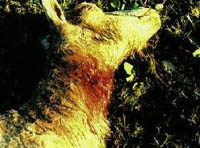Blood-sucking chupacabra goes on rampage in Russian villages
In Russia the first evidence has appeared of a half mythical creature which sucks blood from animals, even large ones. Abroad it is known under the name chupacabra. No one knows for certain what it looks like, but in 2005 a farmer in Texas caught in a trap something looking like a cross between a bald dog, a rat and a kangaroo, which was sucking blood out of his chickens and turkeys.

And now a mystery bloodsucker has appeared around Orenburg. The worries began at the end of March 2005 not far from the regional centre of Saraktash. On the Sapreka farm two farming families suddenly lost 32 turkeys. The bodies of the birds, found in the morning, had been completely drained of blood. None of the farmers either saw or heard the beast that killed them.
Then in the village of Gavrilovka sheep fell victim to the night-time vampire. The unknown animal was also in the hamlets of Vozdvizhenka and Shishma. In the course of the night 3-4 sheep or goats perished. All together the losses in the region amounted to 30 small horned cattle.
The vampire distinguishes itself through its high intelligence. The farmer had just propped the door to the stable, where 8 sheep were housed, shut using an iron bar. The beast threw off the prop and gnawed on four sheep. In the villages people have begun to be afraid of going out into the yard late in the evening and even more so onto the street. The bravest people have kept watch during the night in the hope of picking off the animal.
According to testimonies from villagers, they found traces of bite marks on the throats of the dismembered animals which looked like bullet wounds. Suggestions that it may have been a wolf or a lynx have been refuted. First of all, wolves and dogs eat the meat, gnaw on the carcass, but the mysterious creature merely drank the blood of its prey. A regional specialist for hunting surveillance team, Vasiliy Nechaev, says that lynxes are too cautious, do not approach humans, that even in the winter they are unlikely to enter the village. “Furthermore they attack from behind, whereas there were wounds on the side of the sheep under their lower jaw,” he reasons.
Nevertheless there is some evidence about the baffling creature. As Erbulat Isbasov recalls, he came into contact with it when he was guarding the sheep’s enclosure. “I heard the sheep start to bleat loudly. I run up to them and see a black shadow. It looked like a enormous dog that had stood up on its hind legs. And jumped like a kangaroo. The beast sensed my presence and ran away. It squeezed through an opening in the panels of the fence.”
A few days later Erbulat saw the animal again, after it had left behind a half-metre long ram. This time, when it was running away from the man, the creature easily jumped over the the fence of the compound. The young men managed to glimpse that the animalisabout 1.2 metres tall, and has something like a hump on its back. In the daytime Isbasov discovered some deep claw marks and a clump of ginger-grey fur on the fence.
Alfiya Makasheva who lost two sheep talked of a whole pack of bloodsuckers: “One large creature was reddish, the other dark grey, and behind them a brood of puppies. In the middle of the enclosure the “red” one was turning its head, and was standing on its hind legs, as if it was thinking about something.”
Dmitriy Madinovskii from Orenburg found out about the vampire from his relatives living in Vozdvizhenka. He suspected that the sheep were killed by an animal similar to the legendary South American chupacabra, and decided to track down the animal.
In September 2005 Dmitriy was sailing on the Sakmara river with his friends. About 30-40 kilometres from Vozdvizhenka he noticed two rows of tracks, leading down to the water on the sandy bank. Judging by the depth of the impressions, the creature weighed 30-35 kg. On the pentadactyl paw there were 2-centimetre long claws and membranes. Its tail was dragging in between its paws. The distance between the impressions was about one metre. They photographed the tracks just in case, but neither hunters nor zoologists could say what animal had left them.
“It’s definitely a chupacabra! It has small front and large hind paws. To begin with the animal was walking on four legs, stood on its hind legs at the water, lifting up its long tail, and then started jumping like a kangaroo,” he says. In May Dmitry is determined to seek out the Russian chupacabra along with colleagues from the Ural Ufology Monitoring Station.
Chupacabra, a Spanish word meaning “goat bloodsucker” is a phenomenon which first appeared in mid 1995 in the hills of Puerto Rico. Something strange was killing all the cattle in and around the town of Canovanasa, drinking all their blood. When the corpses were discovered, it turned out that the blood had been sucked out of two small entry wounds (like pin-pricks). The wounds were usually the same diameter as a straw and three-four inches long,” said the local vet who examined several of the bodies.
From 1994 onwards in Mexico, Chile, Peru, Nicaragua, and southern USA bodies of domestic cats, cows and birds, which have had all the blood sucked out of them. According to shepherds, the mysterious beast that attacks the birds and animals is 1-1.2 metres in height. Many remark that the its front limbs are small, some even see wings, or a ridge on its back. The chupacabra’s body is either like a reptile or a dog, its head is elongated, it has membranes between its claws, and has light fur like a bat.
The existence of the chupacabra has not been proven for certain. But among cryptozoologists it has become just as much of an accepted character as the ‘yeti’.
Source: newsru
Translated by James Platt
Subscribe to Pravda.Ru Telegram channel, Facebook, RSS!




